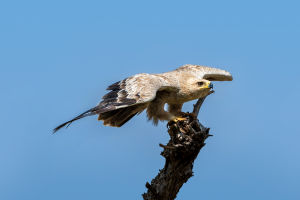
Polar bears are the majestic giants of the Arctic, designed to thrive in one of the harshest environments on Earth. These magnificent creatures are not just large, white bears—they are specialized predators that have adapted perfectly to the extreme cold.
Today, let's dive into the life of the polar bear and explore its incredible adaptations, habitat, and lifestyle. If you're curious about these powerful creatures, this article will give you a detailed look at their fascinating world!
Physical Features
Polar bears are large and sturdy, with a shoulder height that can reach up to 1.6 meters and a body length nearing 3 meters when fully extended. Adult males typically weigh between 300 to 800 kilograms, while females are smaller, ranging from 150 to 300 kilograms. Their fur, which appears white due to light reflecting off hollow, pigment-free hair, helps them blend into their snowy surroundings.
However, in summer, their fur may appear yellowish or brownish due to oxidation. Interestingly, their black skin beneath their fur helps absorb heat, aiding them in surviving in the cold.
Their paws are broad and well-designed for walking on ice and swimming. Each paw spans up to 25 centimeters and has thick fur on the soles, providing insulation and traction. The polar bear’s claws are long and non-retractable, perfect for gripping the icy landscape. They are truly built for survival in the extreme Arctic environment!
Habitat and Distribution
Polar bears are primarily found in the Northern Hemisphere, particularly in regions such as Canada, Greenland, Norway, and Alaska. They reside in areas with large expanses of sea ice, glaciers, and solid land near water sources. With the seasonal melting and freezing of ice, polar bears will travel thousands of kilometers, sometimes moving as far as 1,000 kilometers north or south.
In the summer months, when the ice melts, polar bears often retreat to islands or coastal regions where the ice remains. This is a time when they must adapt to warmer conditions and struggle to find food. As the seasons change, these animals remain incredibly resilient, adjusting to the shifting environment.
Behavior and Sensory Abilities
Polar bears have an incredibly sharp sense of smell—about seven times more sensitive than that of dogs. They can detect prey from over a kilometer away or beneath several feet of snow or ice. However, their vision and hearing are not as developed as their sense of smell, which is their primary tool for hunting.
In terms of activity, polar bears are exceptional swimmers, spending much of their time in the water and on the ice. Roughly 66% of their time is spent resting or lying down, while 29% is spent walking or swimming. They only spend about 1.2% of their time actively hunting, and the remaining time is spent enjoying their meals.
Hunting and Diet
Polar bears primarily hunt seals, particularly ringed seals, which they catch by waiting at breathing holes in the ice. They also hunt seals that come to the surface to bask in the sun. The bears use stealth to sneak up on their prey, hiding behind ice ridges or slipping through cracks in the ice.
Once they catch a seal, they devour the blubber and skin first, often leaving the rest of the carcass behind for other animals like Arctic foxes to scavenge. Polar bears are carnivores, consuming about 98.5% meat. They rely on the high-energy content of seals to maintain their energy reserves and insulating layer, which is crucial for surviving the cold Arctic climate. In addition to seals, they may also hunt walruses, whales, and occasionally birds or small mammals. During summer, they may eat berries or plants to supplement their diet.
Reproductive Behavior and Survival
Polar bears are solitary creatures, with the exception of mothers and their cubs. A female polar bear typically gives birth to twins in the winter, and during this time, she will enter a den, where she remains in isolation for several months. The cubs are born small and helpless, relying entirely on their mother for warmth and nutrition.
One interesting aspect of polar bear behavior is that they enter a form of "hibernation" during the winter. Unlike true hibernators, polar bears do not sleep through the winter. Instead, they enter a semi-dormant state, where they are less active and may not eat for extended periods. They remain alert and can wake up quickly if necessary. This "hibernation" is essential for conserving energy during the harshest months of the year.
Challenges and Threats
Despite their adaptations, polar bears face many challenges. The primary threat to their survival is climate change, which is rapidly meltingthe sea ice that they depend on for hunting and breeding. As the ice melts, polar bears are forced to travel greater distances to find food, and some may even drown while swimming between ice floes. Additionally, polar bears face threats from humans and other bears. Male polar bears are known to harm cubs when they come across them, making it even more difficult for young bears to survive.
Why We Must Protect These Arctic Giants
Polar bears are true survivors of the Arctic, perfectly adapted to one of the most extreme environments on Earth. Their incredible strength, sensory abilities, and specialized hunting techniques make them one of the most fascinating animals to study. However, their future remains uncertain due to the ongoing impacts of climate change. If we want to protect these iconic creatures, we must take action to address the challenges they face. Let's stay informed and continue to support efforts to preserve their fragile habitat!
Thank you for reading about polar bears! If you found this article fascinating, share it with your friends to spread awareness. The more we learn about these incredible animals, the better we can protect them for future generations!
Polar Bears 101 | Nat Geo Wild
Video by Nat Geo Animals


